Greek Mythology In Renaissance Art
Characters from classical Greek gods paintings are inextricably linked to modern culture and life. From classic Greek mythology paintings to modern fine art, the tales of these deities have been repeated and reinterpreted countless times throughout the years. Today, we shall explore this mythology fine art by rating our favorite famous Greek paintings of gods.
Table of Contents
- 1 Exploring Famous Greek Gods Paintings
- i.1 Pallas and the Centaur (1482) by Sandro Botticelli
- one.ii The Nascence of Venus (1486) by Sandro Botticelli
- i.iii The Triumph of Galatea (1514) by Raphael
- i.4 Narcissus (1599) by Caravaggio
- 1.5 Leda and the Swan (1600) by Peter Paul Rubens
- ane.6 The Fall of Phaeton (1605) by Peter Paul Rubens
- 1.7 Prometheus Bound (1612) by Peter Paul Rubens and Frans Snyders
- 1.eight Sleeping Venus (c. 1630) by Artemisia Gentileschi
- one.9 Telemachus and the Nymphs of Calypso (1782) by Angelica Kauffman
- 1.10 Oedipus and the Sphinx (1864) past Gustave Moreau
- 1.11 Pygmalion and Galatea (1890) by Jean-Léon Gérôme
- 1.12 The Complaining for Icarus (1898) past Herbert James Draper
- 1.13 Perseus and Andromeda (1891) by Frederic Leighton
- 1.14 Ulysses and the Sirens (1891) by John William Waterhouse
- one.15 Ariadne (1913) by Giorgio de Chirico
- 2 Frequently Asked Questions
- 2.1 What Is Mythology Art?
- 2.2 Why Did Artists Portray Greek Gods?
Exploring Famous Greek Gods Paintings
The poetry of Ovid exerted a neat effect on the psyche of poets and painters with the rediscovery of ancient antiquity in Greek Renaissance fine art and remained a vital inspiration in the transmission and interpretation of Greek mythology art. Greek mythology paintings were not only peculiarly popular throughout the Renaissance but they also reappeared during the Classical periods of the 18th and 19th centuries.
Let usa now take a look at the most famous Greek paintings of gods that greatly influenced fine art history from the Greek Renaissance art catamenia until today.
Pallas and the Centaur (1482) by Sandro Botticelli
| Appointment Completed | 1482 |
| Medium | Tempera on canvas |
| Dimensions | 204 cm ten 147 cm |
| Current Location | Uffizi, Florence |
Many early Italian Renaissance painters depicted themes from Greek mythology, with disguised connections to Christianity, which had been the dominant religion in the region throughout the centuries before to the movement. Pallas with the Centaur is an artwork by Botticelli that is said to take been painted about 1482, while he was largely engaged in Rome on some of his other masterpieces.
 Pallas and the Centaur (1482) by Sandro Botticelli; Sandro Botticelli, Public domain, via Wikimedia Commons
Pallas and the Centaur (1482) by Sandro Botticelli; Sandro Botticelli, Public domain, via Wikimedia Commons
Pallas is connected with Athena, the goddess of knowledge and innovation, whereas the centaur is generally associated with uncontrollable passion in Greek mythology. The juxtaposition of these 2 people has a variety of meanings, and scholars and historians argue Botticelli'due south motivations for creating the picture.
Although the centaur looks to be subservient to Athena, some speculate that Athena is taming the half-homo/one-half-animal figure in this scenario.
The Birth of Venus (1486) by Sandro Botticelli
| Appointment Completed | 1486 |
| Medium | Oil pigment |
| Dimensions | 172 cm x 278 cm |
| Current Location | Uffizi Gallery |
Sandro Botticelli was a well-known effigy during the early Renaissance period in Italian republic. His paintings mostly depicted Christian characters as well as highly regarded personalities from Italy'south many city-states. Botticelli's paintings, on the other hand, are centered on Greek mythology in a way that honors the features and qualities of legendary beings while also emphasizing the various tales related to them. The Birth of Venus is considered past historians and critics to be one of Botticelli'due south virtually well-known paintings.
This painting from 1486 depicts a landscape that has grown legendary throughout the years since information technology was created.
 The Birth of Venus (1486) by Sandro Botticelli; Sandro Botticelli, Public domain, via Wikimedia Commons
The Birth of Venus (1486) by Sandro Botticelli; Sandro Botticelli, Public domain, via Wikimedia Commons
In the centre of the sheet, the goddess Venus, also known equally Aphrodite in Greek mythology, is vividly displayed. Aphrodite was the goddess of beauty, beloved, and procreation in Greek mythology. On either side of Aphrodite, there are other Greco-Roman deities. These include the wind deity Zephyr, too equally others, although historians and critics disagree over the identities of these gods and goddesses.
The piece is said to have been requested by the powerful Medici family, who dominated Florence at the period, and covers numerous themes relating to historic artists.
The Triumph of Galatea (1514) past Raphael
| Engagement Completed | 1514 |
| Medium | Fresco |
| Dimensions | 300 cm ten 220 cm |
| Current Location | Villa Farnesina, Rome |
Galatea is the goddess of calm waters and one of the 50 Nereides. Polyphemus, the 1-eyed giant, has lured her with melodies from his primitive pipes and dairy and cheese gifts. She had, nonetheless, turned down his attempts and grown to love Acis, a rural shepherd.
Polyphemos fell into a furious frenzy after discovering the two young lovers together and squashed the youngster below a boulder. The nymph, overcome with sadness, inverse her youthful lover into a river. Raphael chose to represent the nymph's apogee while atop a beat-chariot pulled by two dolphins in the moving-picture show.
The artist did not intend for Galatea to stand for any actual existence, but rather to describe ideal dazzler, according to fine art historian Giorgio Vasari.
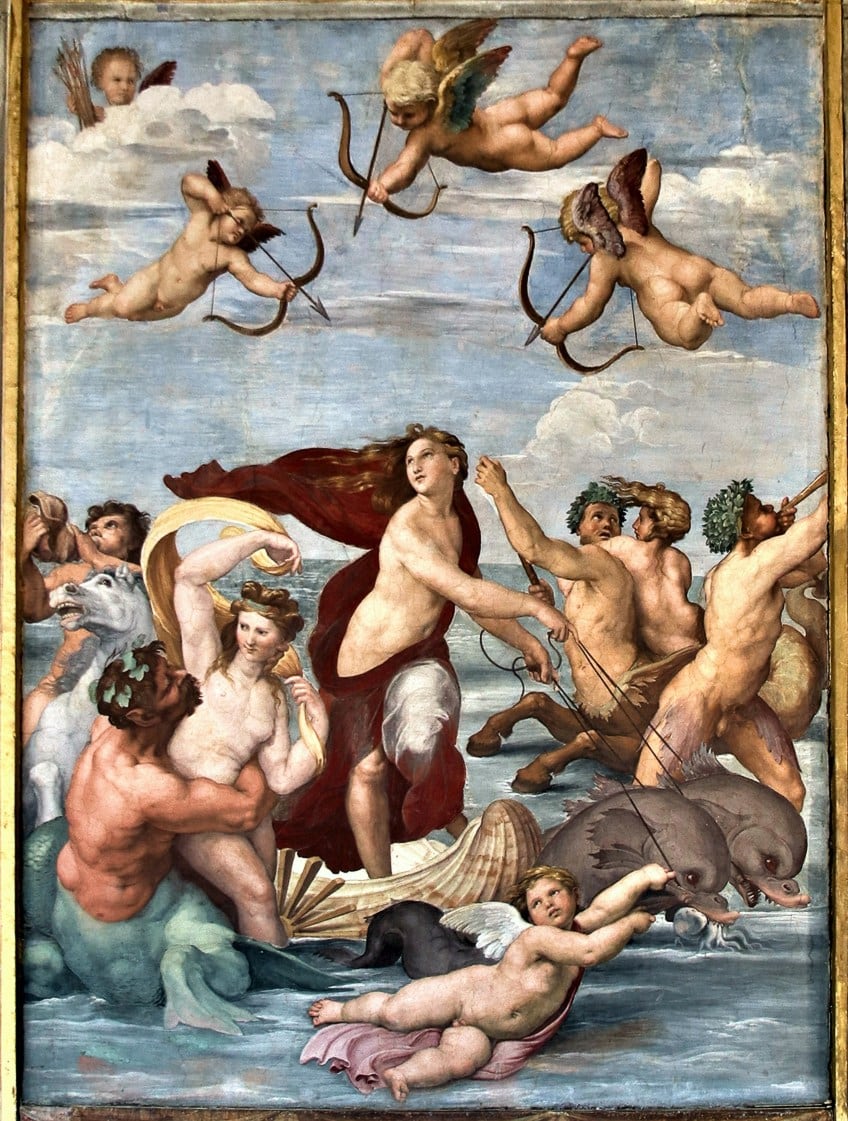 The Triumph of Galatea (1514) by Raphael; Vicenç Valcárcel Pérez, CC Past-SA iv.0, via Wikimedia Eatables
The Triumph of Galatea (1514) by Raphael; Vicenç Valcárcel Pérez, CC Past-SA iv.0, via Wikimedia Eatables
Narcissus (1599) by Caravaggio
| Engagement Completed | 1599 |
| Medium | Oil on sheet |
| Dimensions | 110 cm x 92 cm |
| Current Location | Galleria Nazionale d'Arte Antica |
Narcissus' narrative has been repeated many times in literature, with poets such every bit Petrarch and Dante reinterpreting it and Renaissance painters such equally Caravaggio depicting it. Narcissus was renowned for his beauty, co-ordinate to legend. When he became thirsty while hunting 1 day, he leaned against the stream and imagined himself in the prime of his life.
He vicious completely in beloved with information technology, unaware that it was his own reflection, and was unable to escape the seduction of his image. When he realizes that his dearest will not be returned, he succumbs to his want and transforms into a white and gilt blossom.
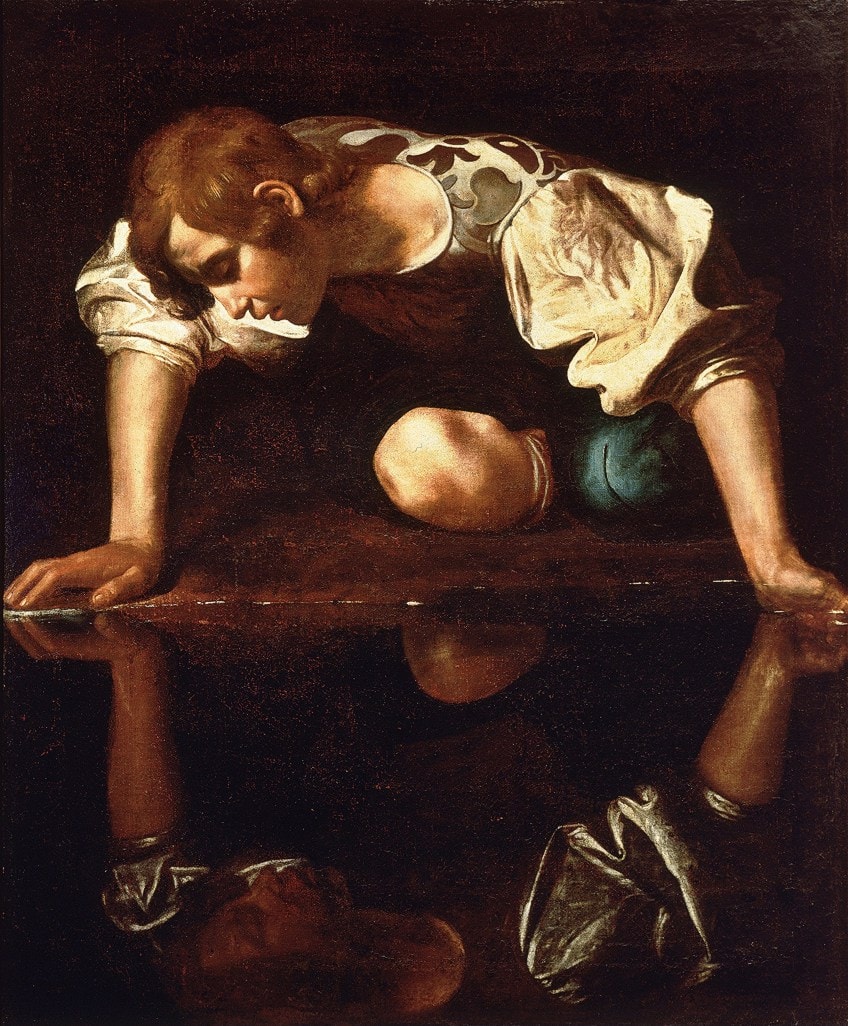 Narcissus (1599) by Caravaggio; Caravaggio, Public domain, via Wikimedia Commons
Narcissus (1599) by Caravaggio; Caravaggio, Public domain, via Wikimedia Commons
This picture features Narcissus in a beautiful brocade doublet staring at his own warped paradigm, ane of ii Caravaggios on a topic from Classical mythology. He is encircled by darkness and locked in a loop with his reflection, suggesting a deep sorrow.
Leda and the Swan (1600) by Peter Paul Rubens
| Date Completed | 1600 |
| Medium | Oil on panel |
| Dimensions | 64 cm x lxxx cm |
| Current Location | Collection of Museum of Fine Arts, Houston |
Leda was seduced past Zeus in the shape of a swan on the very same nighttime she had been with her husband. Subsequently, Leda produced Zeus' offspring Polydeuces and Helen, as well every bit Clytemnestra and Castor, the offspring of her husband. She lay two eggs, co-ordinate to some accounts, from which the children emerged.
Women being absorbed by divinities was a common theme in Renaissance and Baroque fine art, and it was oft shown in a sensuous style.
In this painting by Rubens, the swan touches Leda on her most personal spot, its neck cupped betwixt her breasts, as the creative person represented her naked. The swan is shown every bit an elegant fauna with the ability to ravish.
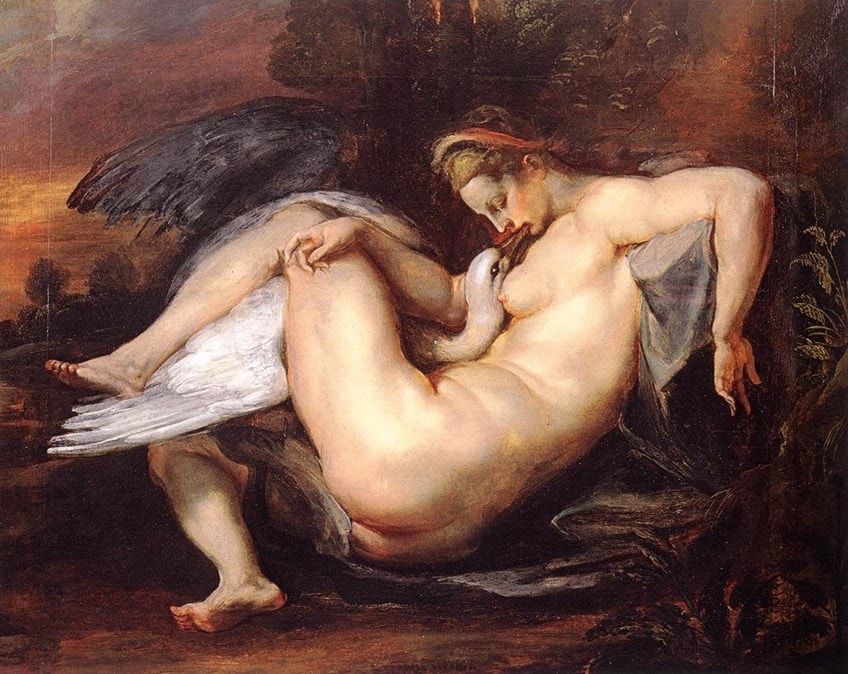 Leda and the Swan (1600) by Peter Paul Rubens; Peter Paul Rubens, Public domain, via Wikimedia Commons
Leda and the Swan (1600) by Peter Paul Rubens; Peter Paul Rubens, Public domain, via Wikimedia Commons
The Fall of Phaeton (1605) by Peter Paul Rubens
| Date Completed | 1605 |
| Medium | Oil on canvas |
| Dimensions | 98 cm 10 131 cm |
| Electric current Location | National Gallery of Art |
The image illustrates the ancient Greek story of Phaeton, a frequent motif in visual arts, and was painted by artist Peter Paul Rubens. Phaeton was the son of Clymene and Helios. Helios vowed to offer him everything he desired if he provided proof that he was actually his son.
Helios attempted unsuccessfully to persuade him not to drive the sun chariot for a day when he insisted on it.
 The Fall of Phaeton (1605) by Peter Paul Rubens; Peter Paul Rubens, Public domain, via Wikimedia Commons
The Fall of Phaeton (1605) by Peter Paul Rubens; Peter Paul Rubens, Public domain, via Wikimedia Commons
He was eventually given command of the chariot, but because of his disability to control the horses, he approached the World too closely, and Zeus knocked him down with a bolt to avert a calamity. Phaeton died every bit a issue of falling from the chariot to the basis. Rubens chose to bear witness the narrative at its near dramatic moment when Zeus' thunderbolts slam into Phaeton's chariot.
The hours and seasons are represented by the butterfly winged feminine figures around him, who respond in panic when the twenty-four hour period and dark cycle is broken by the accident.
Prometheus Jump (1612) by Peter Paul Rubens and Frans Snyders
| Appointment Completed | 1612 |
| Medium | Oil paint |
| Dimensions | 244 cm ten 210 cm |
| Current Location | Philadelphia Museum of Art |
Peter Paul Rubens was a well-known 17th-century artist who was known for depicting legendary figures from both Greco-Roman mythologies in his paintings. He is regarded equally 1 of the virtually important Baroque artists, and he was friends and partners with many of the movement'south other masterpieces, including Diego Velázquez and others. Prometheus Jump was ane of Rubens' most dear paintings during his lifetime.
The painting was completed in 1612 and was a joint effort with another well-known artist, Frans Snyders.
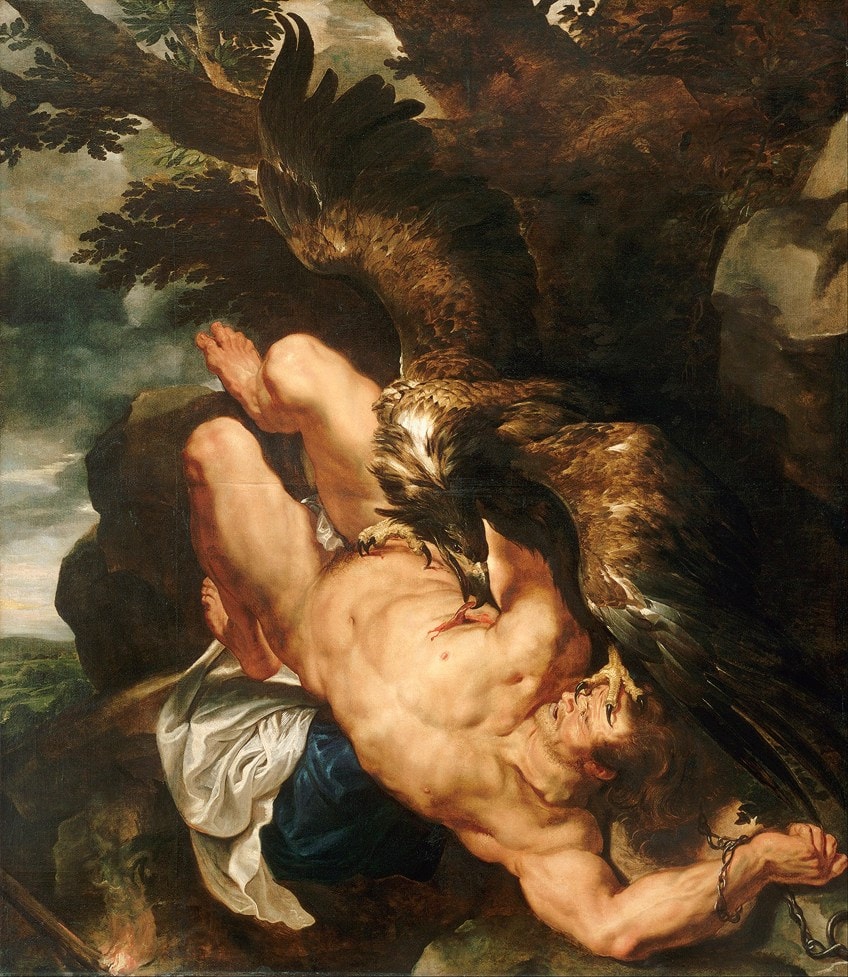 Prometheus Bound (1612) past Peter Paul Rubens and Frans Snyders; Philadelphia Museum of Art, Public domain, via Wikimedia Commons
Prometheus Bound (1612) past Peter Paul Rubens and Frans Snyders; Philadelphia Museum of Art, Public domain, via Wikimedia Commons
It is one of the designer's earliest works to receive nifty appreciation. Rubens painted the effigy of Prometheus, while Snyders produced the gigantic eagle. Since its creation, the artwork has been hailed for its uniqueness and extraordinary realism in depicting the fabled account of Prometheus, which speaks of his liver existence consumed by eagles on a daily basis.
Sleeping Venus (c. 1630) by Artemisia Gentileschi
| Appointment Completed | c. 1630 |
| Medium | Oil pigment |
| Dimensions | 96 cm x 143 cm |
| Current Location | Virginia Museum of Fine Arts |
Her father's artistic technique, too as that of his renowned partner, Michelangelo Merisi da Caravaggio, impacted Artemisia Gentileschi's works, which are distinguished by the dramatic juxtaposition of low-cal and dark as well every bit distinctive, striking compositions.
Her field of study affair often comprises of beautifully presented depictions of women, for example, either as protagonists or victims.
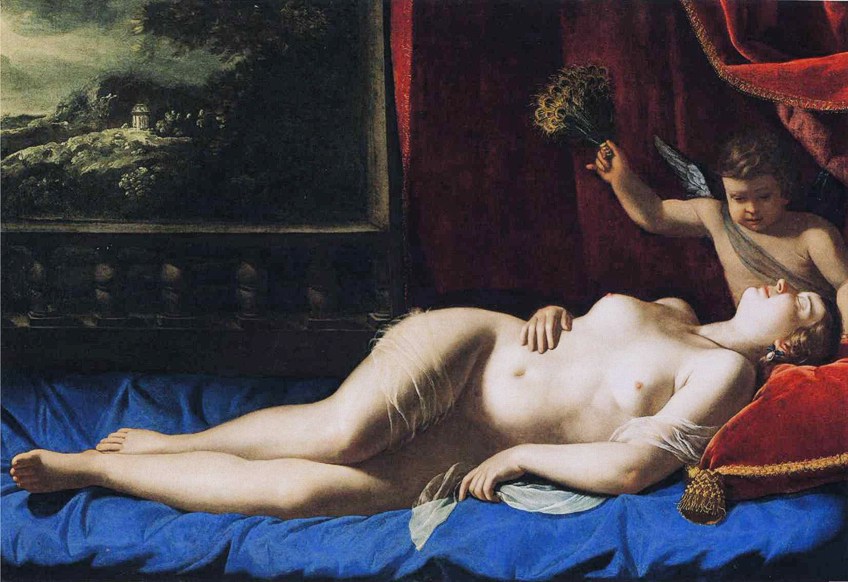 Venus and Cupid (c. 1630) past Artemisia Gentileschi; Artemisia Gentileschi, Public domain, via Wikimedia Commons
Venus and Cupid (c. 1630) past Artemisia Gentileschi; Artemisia Gentileschi, Public domain, via Wikimedia Commons
Artemisia Gentileschi has painted an opulent delineation of Venus, dozing below a velvet drape. Her bedcover is colored with ultramarine, a costly colour derived from crushed lapis lazuli. Cupid, behind her, carries a peacock-feather fan to deter bugs from bothering or awakening her. A hilly terrain with a piddling circular temple, evocative of the i devoted to Venus near Hadrian's dwelling in Tivoli, which is simply exterior Rome, may be seen on the left.
Telemachus and the Nymphs of Calypso (1782) by Angelica Kauffman
| Date Completed | 1782 |
| Medium | Oil paint |
| Dimensions | 82 cm x 182 cm |
| Current Location | Metropolitan Museum of Fine art |
Angelica Kauffman was originally from Switzerland merely rose to prominence in England and Italia, where she had been a founder of the Purple University of Arts. This picture show and its pendant were created for Monsignor Onorato Caetani, who had his likeness created by the artist that very same twelvemonth.
Later pictures of Caetani past Batoni in 1782 illustrate to the close-knit, multinational nature of 18th-century Roman academic circles.
The sculpture shows Telemachus' landing to Calypso's island. Her nymphs greet him with food, vino, and flowers. The deity Athena, masquerading as the sometime person, had been his counselor, and is portrayed being taken away to the left by the sprites.
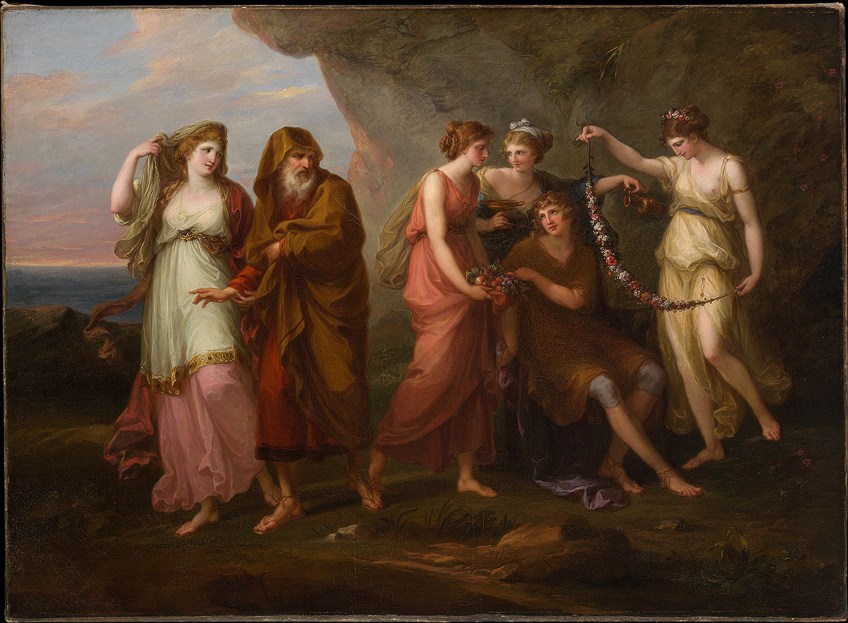 Telemachus and the Nymphs of Calypso (1782) by Angelica Kauffman; Angelica Kauffmann, CC0, via Wikimedia Commons
Telemachus and the Nymphs of Calypso (1782) by Angelica Kauffman; Angelica Kauffmann, CC0, via Wikimedia Commons
Oedipus and the Sphinx (1864) by Gustave Moreau
| Appointment Completed | 1864 |
| Medium | Oil on sail |
| Dimensions | 206 cm x 105 cm |
| Current Location | Metropolitan Museum of Art |
Gustave Moreau'south oil-on-canvas painting, produced in 1864, is a new take on the fabled meeting betwixt the 2 mythical characters on the route to Delphi, which was famously depicted in Sophocles' play Oedipus Rex. Oedipus discovered that the king, Laius, had lately been murdered and that the kingdom was at the whim of the sphinx during his trek between Delphi and Thebes.
The sphinx offered Oedipus a puzzle to reply in lodge for him to laissez passer. Failure to practice so would result in his expiry too as the decease of the imprisoned Thebans.
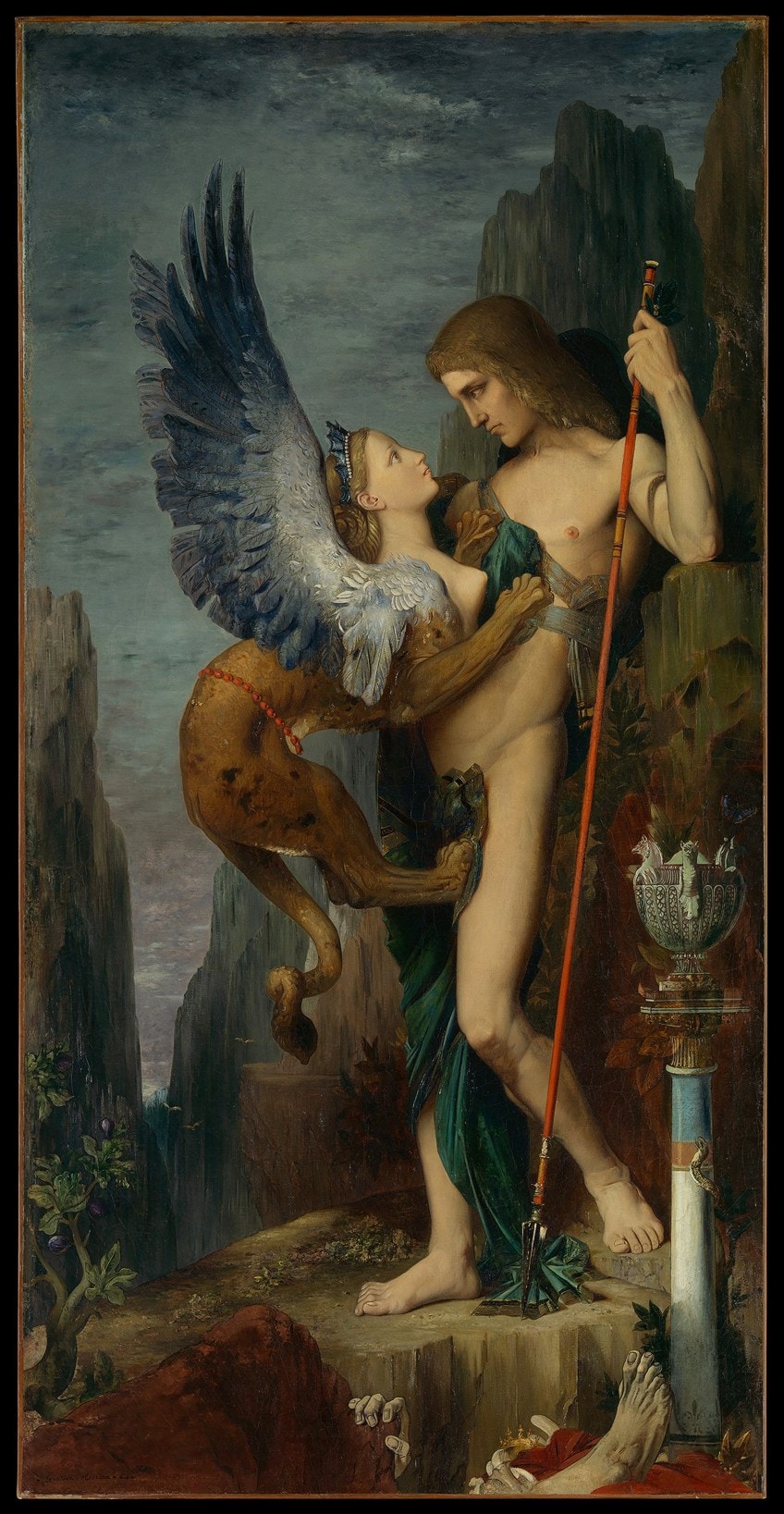 Oedipus and the Sphinx (1864) by Gustave Moreau; Gustave Moreau, CC0, via Wikimedia Eatables
Oedipus and the Sphinx (1864) by Gustave Moreau; Gustave Moreau, CC0, via Wikimedia Eatables
The sphinx sacrificed herself by hurling herself into the sea when Oedipus solved it properly, and Oedipus became the new male monarch. Moreau embraced a purposely antique painting technique and mythical subject matter, purposefully rejecting the prevailing realism of the mid-19th century. The sphinx is on the attack in the piece, clutching at Oedipus, whose success in the boxing is non still secured.
Pygmalion and Galatea (1890) by Jean-Léon Gérôme
| Date Completed | 1890 |
| Medium | Oil on sail |
| Dimensions | 89 cm x 67 cm |
| Current Location | Metropolitan Museum of Fine art |
Jean-Léon Gérôme was a well-known French painter who specialized in Greek mythology paintings. He lived in the 19th century, but dissimilar many of his colleagues, he was not strongly affiliated with popular movements such as Impressionism.
Gérôme created a number of paintings that are among the most well-known Greek gods paintings still in existence today, merely one of his finest masterpieces is regarded to be the most important of them all.
 Pygmalion and Galatea (1890) past Jean-Léon Gérôme; Jean-Léon Gérôme, CC0, via Wikimedia Commons
Pygmalion and Galatea (1890) past Jean-Léon Gérôme; Jean-Léon Gérôme, CC0, via Wikimedia Commons
Pygmalion and Galatea is the title of the moving picture, which was finished in 1890. Information technology shows a scene from a well-known poem by Ovid. The picture portrays Pygmalion, the sculptor, kissing the goddess Aphrodite as she comes to life, as described in the Iliad.
The piece is extremely detailed, comparable to many of Gérôme's other works, and many critics feel it closely reflects the artist'southward real workshop, which housed several of the artists' statues.
The Lament for Icarus (1898) by Herbert James Draper
| Date Completed | 1898 |
| Medium | Oil on sheet |
| Dimensions | 180 cm x 150 cm |
| Current Location | Tate Britain, London |
Another artist recognized for his mythology art that more often than not centered effectually Greek myths is Herbert James Draper. Draper, who was built-in in England in 1863, was a well-known artist who specialized in depicting people and themes from Greek and Roman mythology.
Many of Draper's works are amidst the near well-known Classical masterpieces of the 19th century.
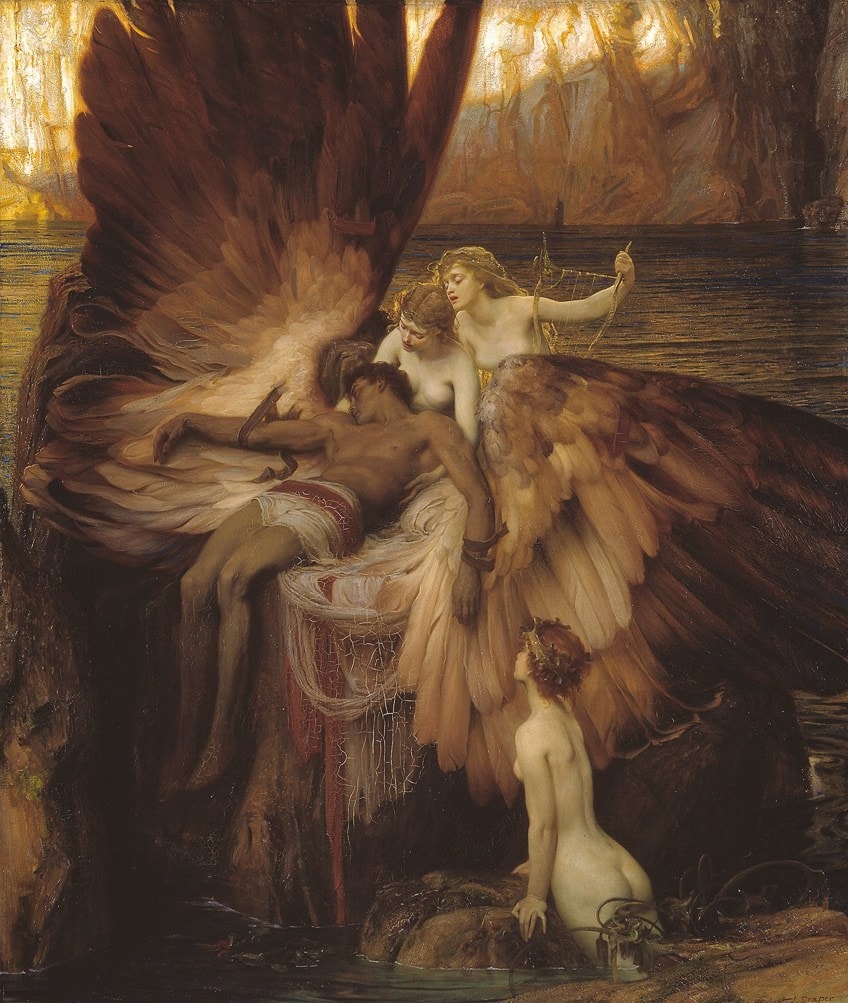 The Lament for Icarus (1898) by Herbert James Draper; Herbert James Draper, Public domain, via Wikimedia Commons
The Lament for Icarus (1898) by Herbert James Draper; Herbert James Draper, Public domain, via Wikimedia Commons
This artwork is said to have been produced around 1898, near the close of a period in which the painter concentrated his attention on painting scenes from Greek mythology. Although many of the more well-known paintings depicting the story of Icarus focus on the instant of his autumn, Draper'south painting focuses on the period following Icarus' decease.
Icarus is encircled by nymphs, and this flick is regarded every bit one of Draper'southward best past several of the well-nigh eminent late-19th-century art critics.
Perseus and Andromeda (1891) by Frederic Leighton
| Date Completed | 1891 |
| Medium | Oil on canvas |
| Dimensions | 235 cm x 129 cm |
| Current Location | Walker Art Gallery, Liverpool |
Andromeda's mythical discipline is presented in a spectacular manner. On a rocky coastline, the setting is a portrayal of the tale. On his winged horse Pegasus, Perseus is pictured flight over the head of Andromeda. He fires an arrow from the air, which strikes the bounding main monster, who raises his head to face up the hero. The black animal'southward wings shade Andromeda's virtually bare, twisted form, offering a visual hint of impending doom. Additionally, Andromeda's graceful form contrasts with the monster'southward uneven and jagged body's black bulk.
Andromeda'due south white torso is represented in pristine and undamaged purity, implying an unjust cede for heavenly retribution intended at her mother rather than herself.
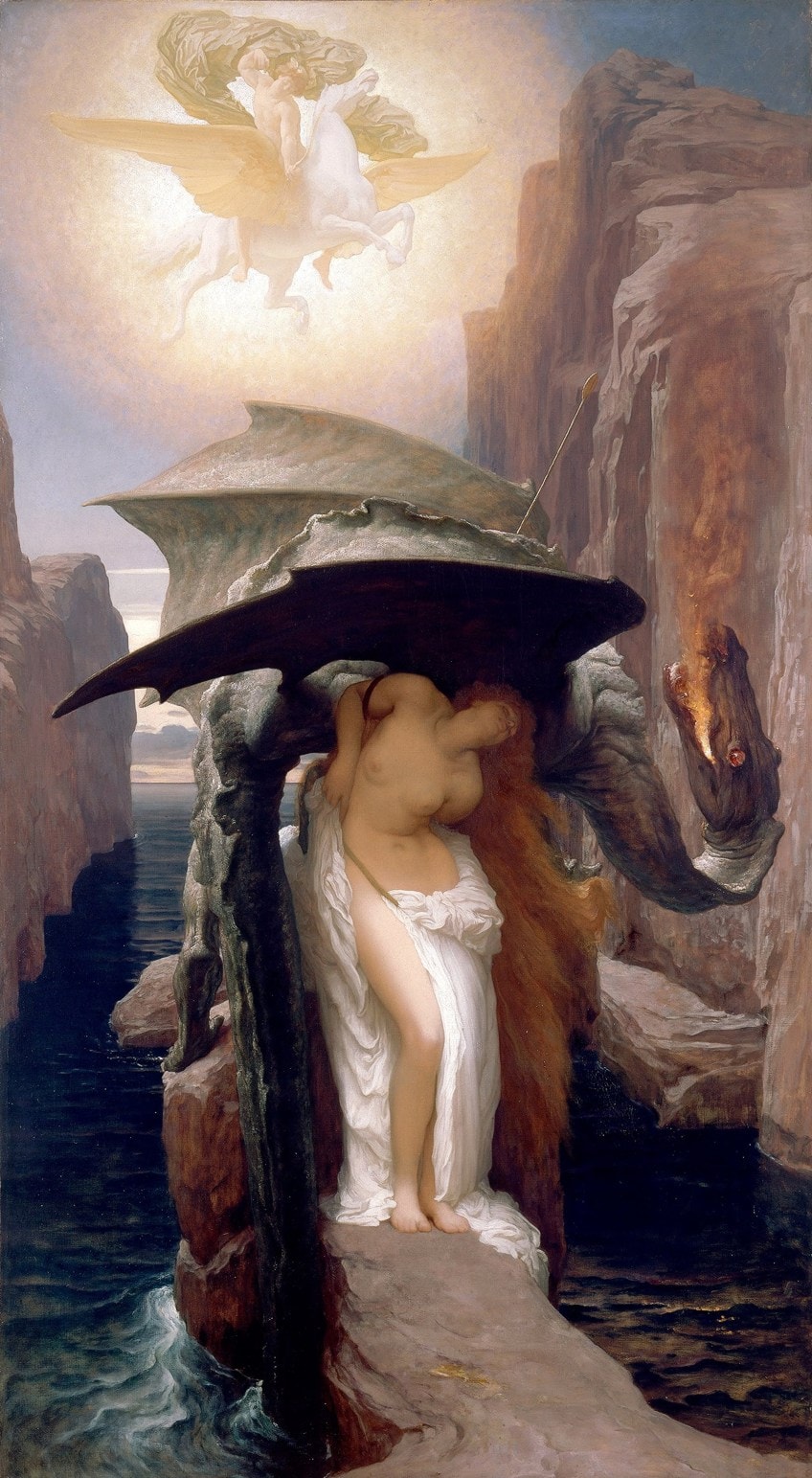 Perseus and Andromeda (1891) by Frederic Leighton; Frederic Leighton, Public domain, via Wikimedia Commons
Perseus and Andromeda (1891) by Frederic Leighton; Frederic Leighton, Public domain, via Wikimedia Commons
A halo of calorie-free surrounds Pegasus and Perseus, symbolically connecting them to the royal's white torso tied to the rock. Earlier beginning work on the painting, Leighton created a miniature bronze-colored plaster figure of Andromeda as a written report.
The figurine was nude, but Leighton covered it with wet materials to obtain the expect he desired in his piece.
Ulysses and the Sirens (1891) by John William Waterhouse
| Date Completed | 1891 |
| Medium | Oil on canvas |
| Dimensions | 100 cm 10 200 cm |
| Current Location | National Gallery of Victoria |
John William Waterhouse was another English creative person who adopted the Academic group's artful only was near known for his paintings showing legendary creatures dressed in costumes and other clothing that was stylish in England at the time. Ulysses with the Sirens is one of Waterhouse'due south most well-known works. This 1891 artwork shows the well-known narrative of Ulysses, with the Greek figure chained to the ship'southward mast in an attempt to proceed him from submitting to the Sirens' seduction.
The demonic songstresses were shown by Waterhouse every bit soaring bird-similar entities with female person heads.
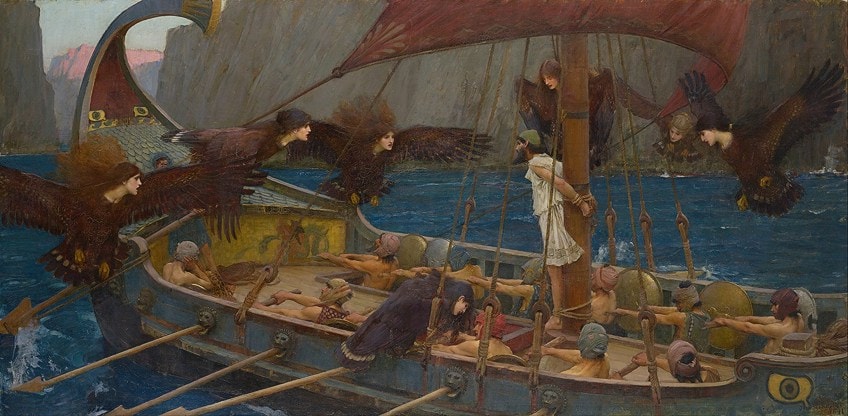 Ulysses and the Sirens (1891) past John William Waterhouse; John William Waterhouse, Public domain, via Wikimedia Commons
Ulysses and the Sirens (1891) past John William Waterhouse; John William Waterhouse, Public domain, via Wikimedia Commons
Ariadne (1913) by Giorgio de Chirico
| Engagement Completed | 1913 |
| Medium | Oil on canvas |
| Dimensions | 135 cm x 180 cm |
| Electric current Location | Metropolitan Museum of Art |
In Greek mythology, Ariadne was a princess who vicious madly in beloved with Theseus, who pledged to slay the Minotaur, a fantastic creature with a man's body and a balderdash's head brought to Minos for tribute by Poseidon. She gave him a blade and a spool of thread to aid him in his quest, so he could backtrack his steps out of the Minotaur'south labyrinth.
She disgraced her father and nation by eloping with Theseus after he slew the fauna. However, he left her comatose on the island of Naxos, where Dionysus found her and married her.
Giorgio de Chirico showed Ariadne sleeping in an unoccupied public plaza in this early 20th-century artwork. The piece represents de Chirico's personal sentiments of loneliness afterward relocating to Paris in 1911, according to the information given by the Metropolitan Museum of Art.
That concludes our look at the famous Greek paintings of gods that influenced not simply Greek Renaissance art just yet impact artists until this very day. With the discovery of classical antiquities in Greek Renaissance art, Ovid's poetry had a significant affect on the heed of poets and painters, and it remained a major inspiration in the transfer and understanding of Greek mythological fine art. Not just were Greek mythology paintings popular throughout the Renaissance, but they also resurfaced during the Classical eras of the 18th and 19th centuries.
Take a look at our Greek mythology paintings webstory hither!
Frequently Asked Questions
What Is Mythology Art?
Mythological images, traditionally defined as a type of history painting, are based on topics borrowed from mythology – that is, legendary narratives constructed to explain a specific conventionalities, major outcome, or natural truth. Fables, tales, and historical stories tin can all serve as inspiration for mythological images. Whatever their origins, these images typically feature figure painting and are more often than not created in a huge size.
Why Did Artists Portray Greek Gods?
Greek mythology has been the attention of artists from a diversity of creative groups dating back well before the Italian Renaissance. Individuals in classical Greece loved and adored deities who had interesting personalities and features that gear up them apart from 1 another. Throughout history, many painters take based their works on the stories and traditions linked with Greek mythical heroes.
Greek Mythology In Renaissance Art,
Source: https://artincontext.org/famous-greek-paintings-of-gods/
Posted by: stevensonhimed1937.blogspot.com


0 Response to "Greek Mythology In Renaissance Art"
Post a Comment